After completing a historic 2-1 Test series win over Australia in their own backyard, has now shifted to One Day Internationals. The ongoing ODI series between India and Australia is tied at 1-1 with the final ODI to take place in Melbourne. With the ICC World Cup set to take place in England this year, all the teams will focus only on the 50-over format of the game, with a few T20Is and the IPL in between, of course.
The World Cup, which will begin on May 30, will see a change of format this year as only 10 teams will be taking part. However, there will be no group stages as such as all the teams will take on each other, with the top four from the round-robin qualifying for the semi-finals.
The Indian cricket team began their World Cup journey in 1975. They have grown from strength to strength since then. From being the underdogs in 1975 to becoming the favourites this year, a lot has changed.
One of the things which has constantly changed is the jersey worn by the team. Every four years, a new jersey is made specifically for the World Cup. Since 1992, the jersey has evolved in colour and in design.
So, let's take a look a the evolution of India's World Cup jerseys through the years.
1975 - 1987 - White jerseys
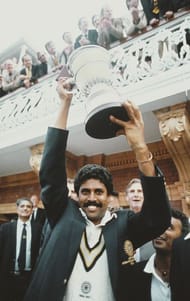
It was not until the 1992 World Cup that coloured jerseys were first used. Until the 1987 World Cup, the teams continued to wear the white which was worn in Tests as well.
And thus, the red ball was used instead of the white in the first three editions of the Cup. India failed to make a mark in 1975 and 1979 as they got knocked out in the group stages itself.
They created history in the 1983 tournament, defeating the favourites, West Indies, at Lord's in dramatic fashion to lift the Cup.
1992 - Dark Blue
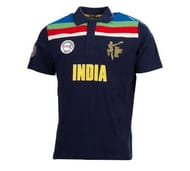
The 1992 World Cup held in Australia and New Zealand was the first edition where the teams wore coloured jerseys.
9 teams took part in the World Cup, including South Africa, who played their first World Cup ever as they were reinstated to the ICC after the end of the Apartheid.
Interestingly, the format of the 2019 World Cup will be similar to that of 1992 one with each team playing each other once before the top 4 qualify for the semi-finals.
Pakistan won the 1992 World Cup, defeating England in the final by 22 runs.
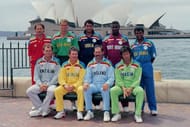
India did not perform too well in the World Cup, finishing a lowly 7th out of 9 teams - they won 2 out of the 8 matches they played. They were led by Mohammed Azharuddin. This was also the first World Cup Sachin Tendulkar played in.
1996 - Light Blue and Yellow
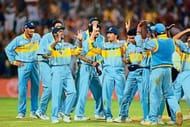
The 1996 World Cup was held in the sub-continent for the first time. There were a lot of controversies from start to finish. Firstly, Australia and West Indies refused to send their teams to Sri Lanka due to safety concerns. This led to Sri Lanka winning their matches against them in the group stage by a walkover.
The other controversy was the one in the semifinals at the Eden Gardens. Indian fans will never forget the image of a teary-eyed Vinod Kambli after the semifinal match against Sri Lanka was forfeited due to the aggressive crowd behaviour.
The jersey worn by India this time around was a much lighter shade of blue along with yellow. The collars were completely yellow as well. There were also rainbow coloured arrows running across the chest and down the sleeves.
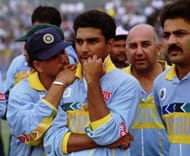
As mentioned above, India reached the semifinals of the tournament, losing to Sri Lanka, who went on to win the World Cup by defeating Australia in the final in Lahore.
1999 - Light Blue and Yellow
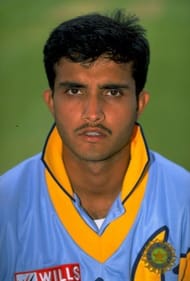
The 1999 World Cup was held in England with 12 teams participating. The teams were divided into two groups of six each, with the Super Six that followed. India finished second in their group but performed extremely poorly in the Super Six, winning just one match.
Eventually, Australia defeated Pakistan in the final after a nerve-racking semifinal against South Africa.
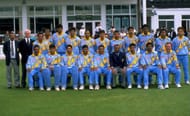
The jersey worn by the Indian side was similar to that worn in the 1996 edition. However, the yellow was slightly more prominent this time. A diagonal yellow pattern yellow with a black border ran across the chest while the rest of the jersey was blue. The collars were yellow once again but with a black border.
2003 - Blue with black patches and tri-colour
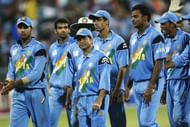
The 2003 World Cup will go down as one of India's most successful tournaments ever, apart from the 2011 and 1983 one, of course.
The tournament was held in South Africa where 14 teams took part, divided into two groups. The format was similar to the 1999 tournament with the Super Six stage taking place after the group stages. India defied the odds to reach the final. However, they were defeated quite comfortably by Australia to hand them their second consecutive title.
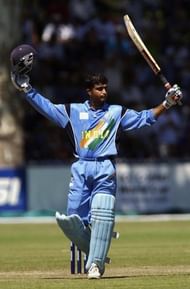
The jersey was a huge upgrade from the previous ones and was loved by the fans. The shade of blue was slightly darker from the previous editions and the yellow was almost completely removed. The tri-nation colour stood out in front of the jersey with black patches on the shoulders and sides.
2007 - Light Blue with tri-colour
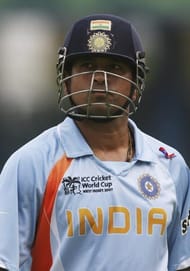
2007 will go down as one of the darkest years in the 50-over format for India as they lost in the group stages of the tournament held in West Indies. Despite starting as favourites, India were upsetted by Bangladesh in their first match. They went on to lose to Sri Lanka as well as they were knocked out.
A record 16 teams took part with 4 teams in each group. India finished third in their group and failed to qualify for the Super 8 stage. Australia won their third consecutive World Cup by defeating Sri Lanka in the final.
The jersey was quite different from the one worn in 2003. The shade of blue was a lot lighter, much like the one worn in 1996. The tri-colour was strapped on the right side while "India" was sewn across the middle in yellow.
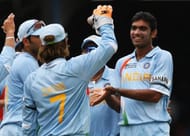
2011 - Darker Blue with tri-colour
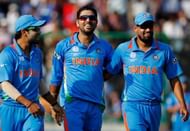
The 2011 World Cup will not be forgotten by Indian fans for years to come. The Men in Blue lifted the trophy in their own backyard (Mumbai) by defeating Sri Lanka in the final by 6 wickets.
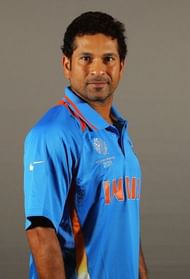
14 teams took part in the tournament, with 7 teams in 2 groups - the top 4 from each qualified for the quarter-finals. Yuvraj Singh was named the 'man of the tournament' for his exceptional all-round performances.
The design of the jersey was similar to that which was used in 2007. However, the colours changed, as the blue became darker and the "INDIA" became orange. The player names were also written in orange.
2015 - Blue and Orange(made out of recycled bottles)
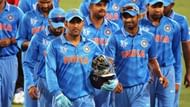
The 2015 World Cup was held in Australia and New Zealand. Interestingly, these two teams competed in the final as well, with Australia coming out on top.
The format was the same as the 2011 one, with 14 teams taking part.
India did exceptionally well in the group stages, not losing a single game. They defeated Bangladesh in the quarter-final with ease but then fell to Australia by 95 runs in the semis.
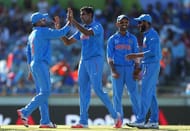
The jerseys, which were sponsored by Nike, were made out of 33 recycled plastic bottles. The design was quite simple. The shade of blue was similar to that used in 2011 and there were patterns of slightly darker blue all across the jersey. The team name was written in orange once again but with a white border this time.
2019 - To be announced
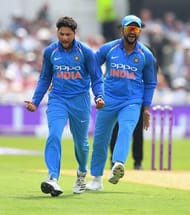
The 2019 World Cup will be held in England. The number of teams has been reduced from 14 to 10 and the format is similar to that of 1992.
All 10 teams will take on each other in the round-robin format and the top four will qualify for the semifinals.
The BCCI has not released the jersey yet. However, the colour and design would most likely be similar to what the Indian ODI side are currently wearing.
Brand-new app in a brand-new avatar! Download CricRocket for fast cricket scores, rocket flicks, super notifications and much more! 🚀☄️
